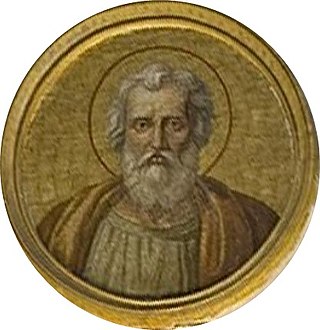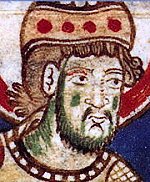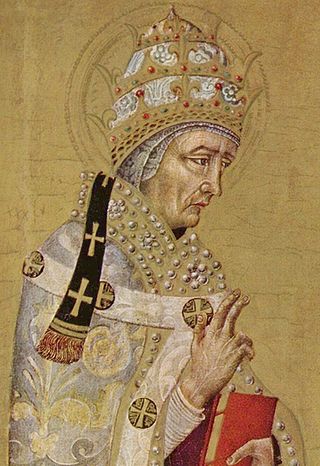Related Research Articles

Antipope Felix was a Roman archdeacon in the 4th century who was installed irregularly in 355 as an antipope and reigned until 365 after Emperor Constantius II banished the then current pope, Liberius. Constantius, following the refusal of the laity to accept Felix, attempted to have them co-rule, but Felix was forced to retire. He was resented in his lifetime but has enjoyed a more popular memory since.
Pope Anastasius II was the bishop of Rome from 24 November 496 to his death. He was an important figure in trying to end the Acacian schism, but his efforts resulted in the Laurentian schism, which followed his death. Anastasius was born in Rome, the son of a priest, and is buried in St. Peter's Basilica.

Pope Damasus I, known as Damasus of Rome, was the bishop of Rome from October 366 to his death. He presided over the Council of Rome of 382 that determined the canon or official list of sacred scripture. He spoke out against major heresies, thus solidifying the faith of the Catholic Church, and encouraged production of the Vulgate Bible with his support for Jerome. He helped reconcile the relations between the Church of Rome and the Church of Antioch, and encouraged the veneration of martyrs.

Year 366 (CCCLXVI) was a common year starting on Sunday of the Julian calendar. At the time, it was known as the Year of the Consulship of Gratianus and Dagalaifus. The denomination 366 for this year has been used since the early medieval period, when the Anno Domini calendar era became the prevalent method in Europe for naming years.
The 350s decade ran from January 1, 350, to December 31, 359.
Pope Liberius was the bishop of Rome from 17 May 352 until his death. According to the Catalogus Liberianus, he was consecrated on 22 May as the successor to Pope Julius I. He is not mentioned as a saint in the Roman Martyrology. That makes him the earliest pontiff not to be venerated as a saint in the Roman Rite and one of only two popes to be omitted from Roman Catholic sainthood in the first 500 years of church history.
Pope John I was the bishop of Rome from 13 August 523 to his death. He was a native of Siena, in Italy. He was sent on a diplomatic mission to Constantinople by the Ostrogoth King Theoderic to negotiate better treatment for Arians. Although John was relatively successful, upon his return to Ravenna, Theoderic had him imprisoned for allegedly conspiring with Constantinople. The frail pope died of neglect and ill-treatment.
Liberius may refer to:
Ursicinus, also known as Ursinus, was elected pope in a violently contested election in 366 as a rival to Pope Damasus I. He ruled in Rome for several months in 366–367, was afterwards declared antipope, and died after 381.

Peter Chrysologus was Bishop of Ravenna from about 433 until his death. He is known as the “Doctor of Homilies” for the concise but theologically rich reflections he delivered during his time as the Bishop of Ravenna.

Apollinaris of Ravenna is a Syrian saint, whom the Roman Martyrology describes as "a bishop who, according to tradition, while spreading among the nations the unsearchable riches of Christ, led his flock as a good shepherd and honoured the Church of Classis near Ravenna by a glorious martyrdom."

The Basilica of Sant' Apollinare in Classe is a church in Classe, Ravenna, Italy, consecrated on 9 May 549 by the bishop Maximian and dedicated to Saint Apollinaris, the first bishop of Ravenna and Classe. An important monument of Byzantine art, in 1996 it was inscribed with seven other nearby monuments in the UNESCO World Heritage List, which described it as "an outstanding example of the early Christian basilica in its purity and simplicity of its design and use of space and in the sumptuous nature of its decoration".

The Basilica of San Vitale is a late antique church in Ravenna, Italy. The sixth-century church is an important surviving example of early Christian Byzantine art and architecture. It is one of eight structures in Ravenna inscribed on the UNESCO World Heritage List. Its foundational inscription describes the church as a basilica, though its centrally-planned design is not typical of the basilica form. Within the Roman Catholic Church it holds the honorific title of basilica for its historic and ecclesial importance.
This page is a list of Catholic bishops and archbishops of Ravenna and, from 1947 of the Archdiocese of Ravenna and Cervia, which in 1985 became styled the Archdiocese of Ravenna-Cervia. The earlier bishops were frequently tied to the Exarchate of Ravenna.

The Archdiocese of Ravenna-Cervia is a metropolitan archdiocese of the Roman Catholic Church in the Emilia-Romagna region of Italy.

The selection of the pope, the bishop of Rome and supreme pontiff of the Roman Catholic Church, prior to the promulgation of In nomine Domini in 1059 varied throughout history. Popes were often appointed by their predecessors or by political rulers. While some kind of election often characterized the procedure, an election that included meaningful participation of the laity was rare, especially as the popes' claims to temporal power solidified into the Papal States. The practice of papal appointment during this period would later result in the jus exclusivae, i.e., a right to veto the selection that Catholic monarchs exercised into the twentieth century.

Constantine the Great's (272–337) relationship with the four Bishops of Rome during his reign is an important component of the history of the Papacy, and more generally the history of the Catholic Church.

August 26 - Eastern Orthodox liturgical calendar - August 28

Dionysius was bishop of Milan from 349 to 355. He is honoured as a Saint in the Catholic and Eastern Orthodox Churches and his feast day is 25 May.

December 29 - Eastern Orthodox liturgical calendar - December 31
References
- ↑ St. Liberius Catholic Online
- ↑ Saint Liberius of Ravenna Archived 2010-01-17 at the Wayback Machine Patron Saints Index